| کد مقاله | کد نشریه | سال انتشار | مقاله انگلیسی | نسخه تمام متن |
|---|---|---|---|---|
| 4389375 | 1618030 | 2014 | 7 صفحه PDF | دانلود رایگان |
The sorption of phosphorus (P) onto solid mediums (soil, sediment and P removing materials) is characterized by a rapid sorption phase followed by a slow phase. No studies have yet attempted to quantitatively distinguish between the two stages. In this study, efforts are made to develop a method that can separate the sorption process into fast and slow stages. According to the geometrical shape of P sorption curves, a maximum curvature value points (MCVP) algorithm is presented as the change point based on the most widely used P sorption models (Langmuir and Freundlich isotherm equation, first-order, second-order and Elovich kinetic equation). Results showed that the MCVP successfully separates the sorption process into a fast stage and then a relatively slow one. General analysis formulas of the MCVP for the most commonly used models are described in this paper. Two steps are recommended before the MCVP calculation: first, independent and dependent variables should be plotted in the same order of magnitude (1:1 is the best), free from the axis scale effect; second, the model that best describes the data points should be used to quantify the MCVP. With the MCVP, it is easy for researchers to obtain the change point by substituting the parameters of sorption models, particularly for materials that have been tested before. The significance of this study is that it allows for optimization of the reaction time in P removal technology and furthers our understanding of P distribution characteristics in soil or sediment.
Journal: Ecological Engineering - Volume 69, August 2014, Pages 63–69
